As long as your bonsai is properly positioned, watered, fed, and replanted on a regular basis, it should grow vigorously. After that, it is time to shape and groom the tree, which requires the development of certain skills.
In terms of pruning bonsai, there are two types of pruning: structural pruning and maintenance pruning aka refinement pruning.
Structural bonsai pruning: It is the first hard pruning given to a tree or shrub to establish the structure of the bonsai tree.
Maintenance bonsai pruning: In order to enhance the appearance of bonsai that are already shaped, refinement shaping is performed. In order to maintain a small and neat bonsai, light pruning and pinching are required on a regular basis.
Maintenance pruning along with wiring the bonsai tree will result in the making of a beautiful bonsai specimen.
What are the rules for pruning bonsai?
Performing a ‘basic cut‘ on a young plant is the first step in creating a bonsai. Please check out When should a bonsai tree be pruned? to know the best time to prune a bonsai tree.
However, we must take into account one key principle of bonsai culture which is, rather than rigidly adhering to rules, it is important to understand the character of the tree-to-be.
Therefore consider these rules as a general guideline for how to trim a bonsai tree for the first time.
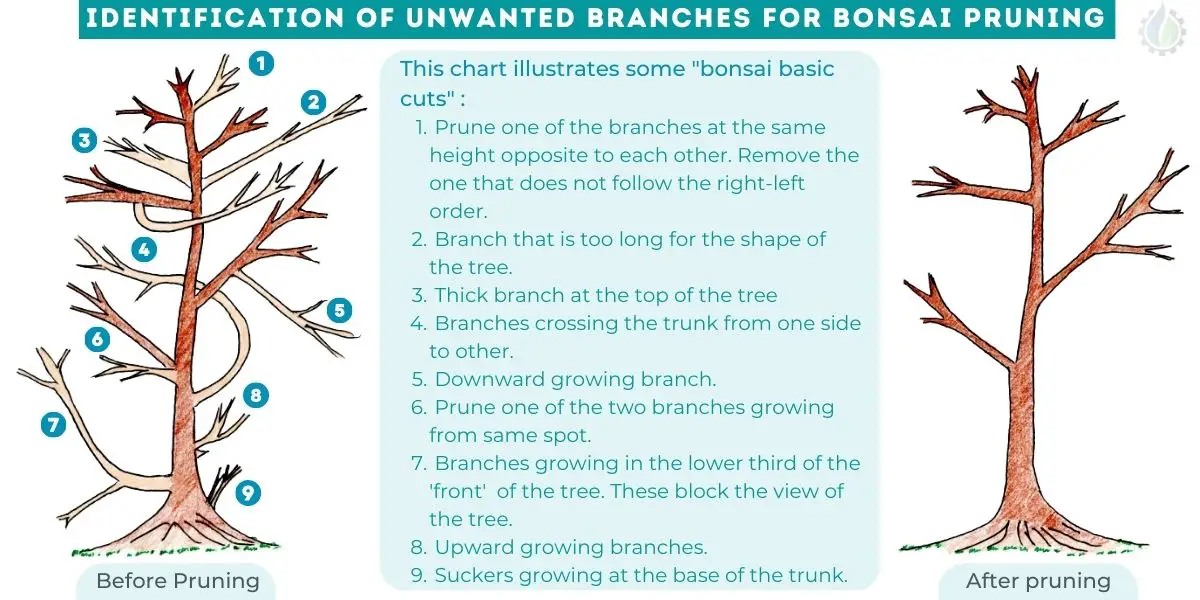
- If there are two branches that are growing opposite each other, remove the branch that does not follow the left-right alternating pattern of the branches. This is also a good practice to promote the tree is producing more alternating branches.
- Prune branches that are too long for the shape of the bonsai tree.
- Prune thick branches in the upper part of the tree.
- Prune the branches that grow on one side of the trunk and cross over to the other. Also remove unsightly side branches that cross other branches.
- Prune the branches that are pointing downwards.
- If there are two branches emerging from the same point, choose a suitable branch that suits the shape of your bonsai and remove the other branch.
- Prune the branches in the lower third of the ‘front’ of the tree. When you look at the bonsai from the front, you should be able to see the tree trunk and core of the bonsai. A tree’s trunk and branches should be visible as much as possible from the front.
Remove the forward-facing branches. They should only be allowed to grow from the sides and the back. Have only forward-facing branches on the upper half of the bonsai.
Make sure that there is no branch blocking the front view. - Prune the branches that are growing vertically upwards.
- The suckers growing at the base of the trunk should be removed.
If you are planning to prune a tree, you should always allow yourself enough time. When pruning, examine the shape of the tree frequently. Consider how the plant’s form will change if twigs and branches are removed.
In the beginning, many people find it hard to muster the courage of pruning the bonsai. However, when you realize the ‘character’ of a tree, you will find the confidence and courage needed.
How do you shape a bonsai tree?
As discussed before, majority of the foundation of shaping of the bonsai is bone by structural bonsai pruning. Choose a bonsai style you desire and just follow the bonsai pruning rules and make sure that your bonsai adheres to the principle of “triangularity“.
In nature, the lower branches of a tree are covered by the higher branches. As a result, they lengthen in search of light. Hence the foliage of the tree always assumes a triangular structure.
Therefore, in order to mimic a tree in nature as closely as possible, a bonsai should have a triangular shape.
As mentioned earlier, hard pruning is done at the time of structural pruning. The time of hard pruning depends on the bonsai tree species. (click on the highlighted text and read about various types of bonsai trees- More than 100 species listed)
It is very important to understand that the in the art of bonsai, it is not just the shape of the bonsai tree which is considered. The bonsai pot used for the bonsai tree is equally important.
Following are some bonsai tree shaping rules you should follow to have the best harmony between the bonsai pot and bonsai tree.
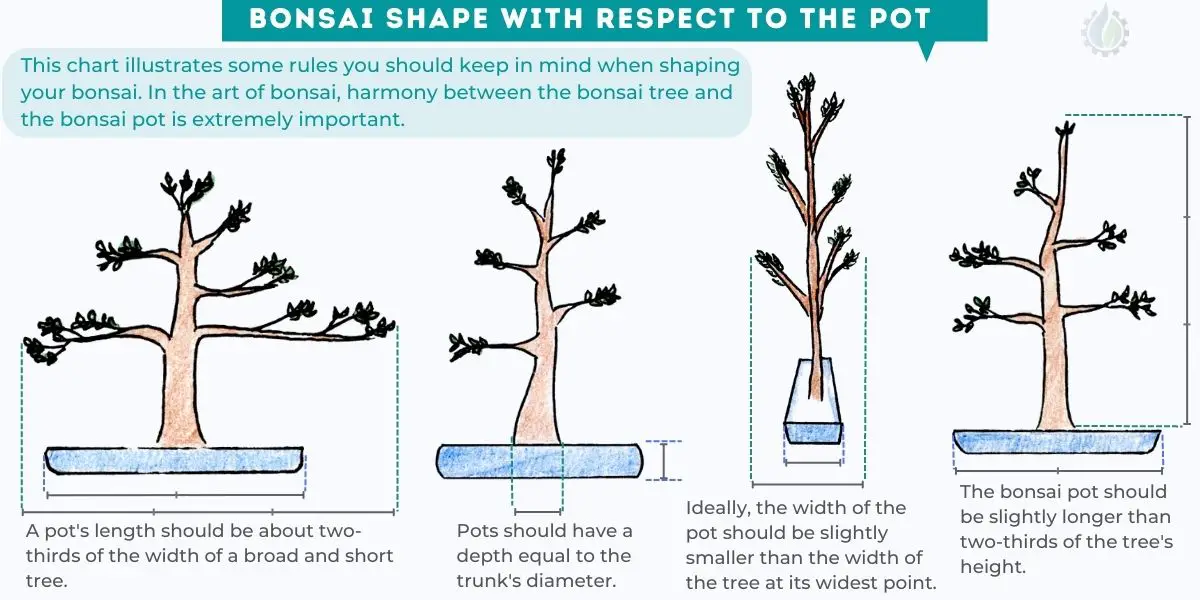
Although this is something related more to choosing a pot for your bonsai, this will certainly gives you a guideline on shaping your bonsai if you are pruning your bonsai on a finalized bonsai container.
What do you use to trim a bonsai tree?
Which tool to use while trimming a bonsai tree depends on which part of the tree you are trying to prune.
For instance, if you are trying to prune thin shoots or leafstalk, you can use a sharp pruning shear. If you are trying to remove the knobs of wood on the trunk or branches (which are left after branch pruning), you will need knob cutters. If you are trying to prune a heavy root of the bonsai tree, you might end up using heavy root cutters.
Following is the list of bonsai pruning tools:
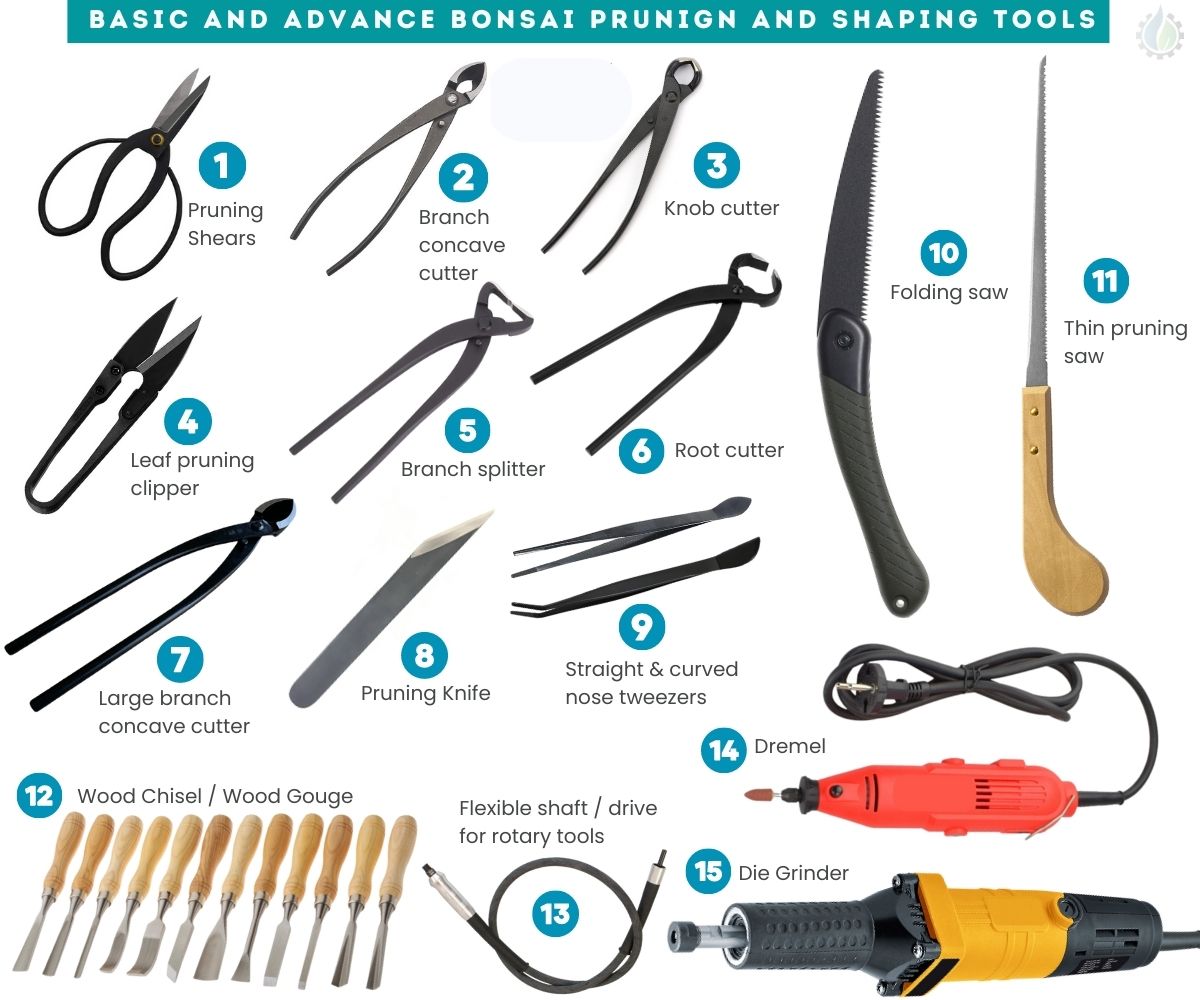
- Pruning Shears / root shears
- Branch concave cutter
- Knob cutter
- Leaf pruning clipper / standard leaf shears
- Branch splitter
- Root cutter
- Large branch concave cutter
- Pruning Knife
- Straight & curved nose tweezers
- Folding saw
- Thin pruning saw
- Wood Chisel / Wood Gouge
- Flexible shaft / drive for rotary tools
- Dremel
- Die Grinder
It is always advisable to invest in high quality tools. It is also advisable to keep a separate set of root shears away from the primary set of shears you use for branch and leaf pruning. Read bonsai tools to know more about all the tools used in the art of bonsai (eg. wire cutter, pliers, metal and nylon brush etc).
What is the best tool for pruning bonsai?
There can not be a single bonsai tool which can be considered as best for bonsai pruning. Each bonsai tool has a specific purpose, and it cannot perform the functions of another tool. As an example, pruning shears cannot be used to cut thick branches (which can be handled by branch cutters) or in place of tweezers when pinching leaf buds.
Where do you cut bonsai branches?
Beginners may have difficulty deciding which branches to remove at first, but once they consider the bonsai’s shape in general, the decision becomes easier.
Following image has the illustration of where to cut the branches in your bonsai to form the foundational structure of your bonsai tree.
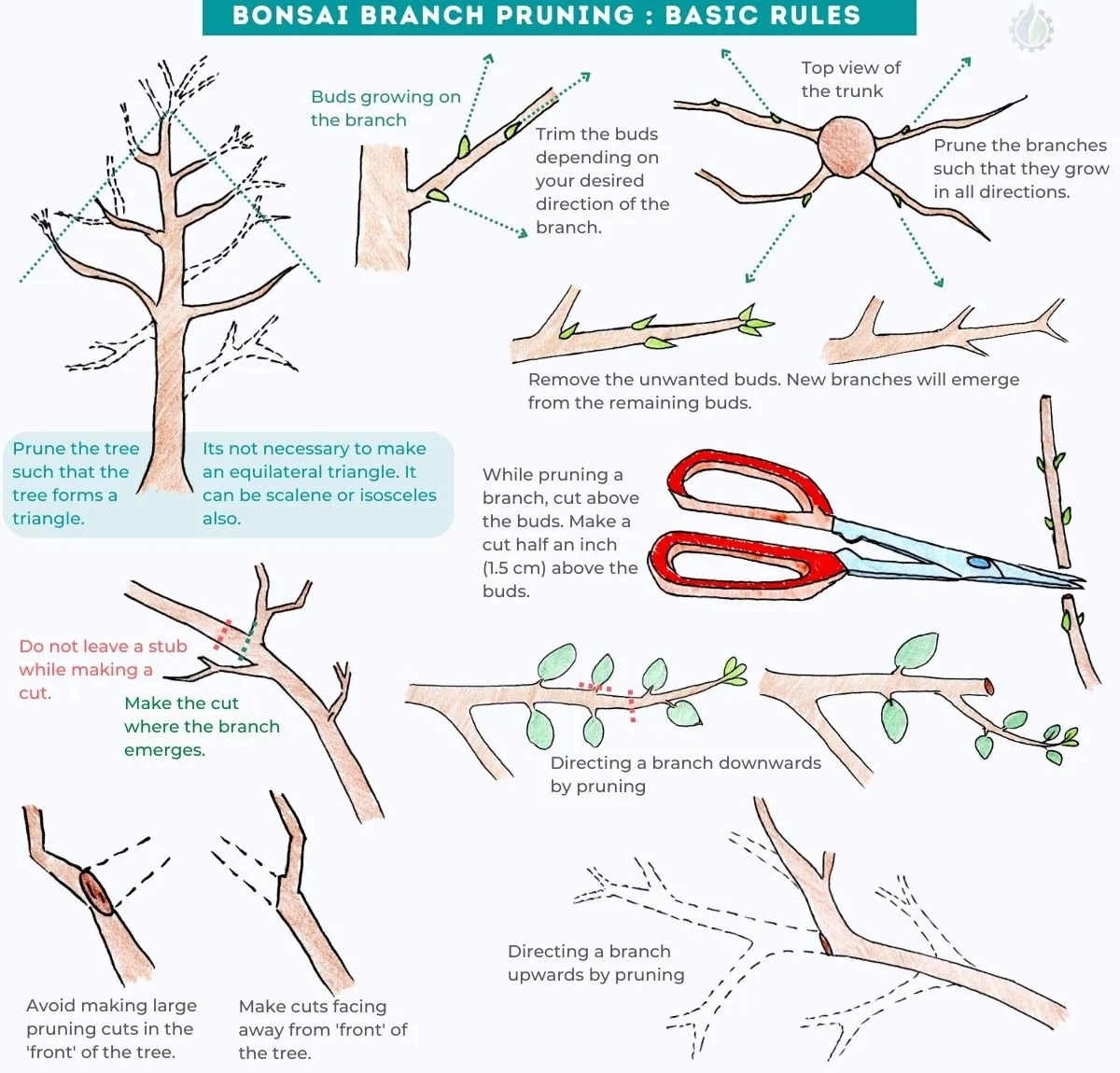
First, make sure that you remove the unwanted branches (aka “Imi-eda” in Japanese) or unwanted parts of the branch and your bonsai tree adheres to the basic rules of bonsai as closely as possible.
- The bonsai tree should have branches ‘flowing’ in all the directions. In case your tree lacks this character, look for small buds on the branches which point to the desired direction. Prune those branches till these buds. These duds will grow and turn into branches which will have the desired direction.
- When you prune the branches uptill the bud, make a cut almost half an inch (1.5 cm) beyond the bud.
- Also remove the unwanted buds to prevent the growth of unwanted branches. This will save the tree’s energy to focus on the rest of the branches.
- You can even change the direction of the main branch. Directing the branch upwards is done by pruning the main branch uptill the secondary branch which is moving upwards.
- Similarly, a branch can be directed downwards by pruning the main branch till the point where a secondary branch will grow downwards. A branch pointing downwards is not always bad for the bonsai tree. This branch adds a three dimensional aspect to the bonsai tree instead of the tree looking flat.
- While pruning a branch, prune at the point where the secondary branch emerges. However, this does not apply to all the trees. Leaving a stub depends on the type of the bonsai tree. For instance, leave a small stub behind in case of trees which ooze sap from the wounds. You can remove these stubs when you are confident that the sap has dried.
- Whenever you are pruning branches, especially making large pruning cuts, always try your best to make a cut facing away from the front of the tree. Pruning wounds in the front of the tree look unsightly.
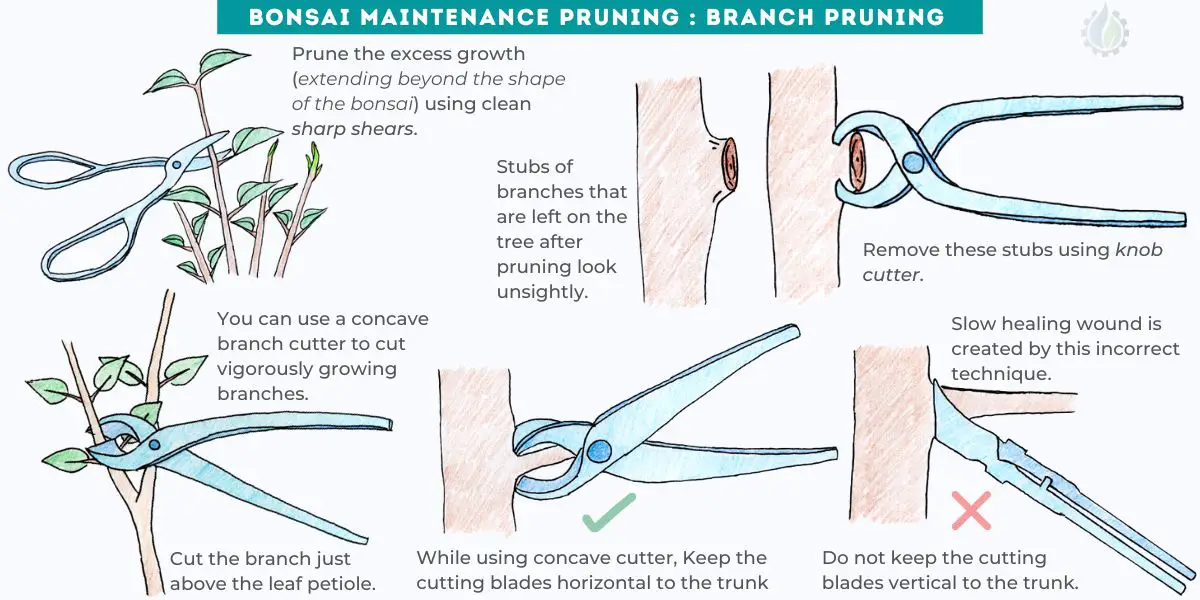
- Shoot pruning on a bonsai: With one hand, hold the shoot in place and prune the over extended part just above a leaf or a node. Use clean and sharp scissors.
- Maintain the shape of the tree’s top by severely pruning it. Most bonsai tree species show faster growth habits on the top, so severe pruning is necessary. Prune back to one or two nodes from three to five nodes.
- However, when pruning the lower branches, leave more nodes (three to more nodes). This will not only keep the lower branches longer (maintaining the triangular shape of the tree) but also help in providing the tree with more strength.
- Also, you should take fewer shoots from the lower branches, since they grow at a slower pace.
- If you have a flowering bonsai, you should remove the shoots once the flowers have withered.
- After removal of shoots, new shoots will emerge further back on the branch. The distance between the leaf nodes on these new shoots will be shorter. This gives amazing results by producing denser foliage growth and makes the tree look twiggy and ancient.
- When removing a branch from the trunk, use a concave branch cutter.
- The angled blades of a concave cutter leave a slight hollow cavity in the trunk. When the pruning wound heals, scar tissue fills the wound and the pruning wound and the trunk are at the same level. Different types of concave cutters with different handle lengths are available, such as: narrow blade or curved jaw.
- Keep the cutting blades of the concave cutter horizontal to the trunk at the time of pruning the branch.
- The cutting blades should not be placed vertically on the trunk. This will lead to a vertical split wound on the trunk. And this wound heals slowly.
- Pruning a branch with regular pruners (like shears, saws etc) usually leaves a bump of scar tissue on the tree after the wound heals. Wood chisels / wood gouges can be used to hollow out pruning cuts made with regular pruners. Similar to using a concave cutter, this will produce the same effect.
- When a stub is left at the base of a pruned branch, use a knob cutter to remove it. As with concave cutters, knob cutters have angled cutting teeth that leave the same type of hollow wound.
- Make sure to remove any burrs from the wounds using a sharp pruning knife.
- Mask the fresh cut with a sealant after pruning.
Should I use cut paste on bonsai?
The use of cut paste depends on factors like: your environment, type of the bonsai tree, type of the pruning activity you are performing on the tree.
If the environment around your bonsai tree is conducive to the bonsai pest and diseases, covering the wound with a cut paste is a wise idea. Sealing the wounds will prevent the diseases to attack the open wound of the tree.
Use of cut paste also depends on the type of bonsai tree you are working with. For example, you should use cut paste on trees like Birch (which bleed copiously) or Ficus (exude milky latex). However, trees like Pinus mugo (exude a resin which acts as a cut paste) might not need cut paste. Large wounds created after pruning of large branches on of non-resinous trees will require sealing the wound with cut paste.
The type of pruning activity also dictates whether to use cut paste or not. For example, cut paste is applied to the edge of the bark at the time of creating Jins and Sharis, it can be applied to the large ‘V-shaped’ pruning wound on the trunk of the tree at the time of creating broom bonsai style, it can be applied to the wound when accidentally a branch snaps but does not break, or it can even be used at the time of grafting instead of grafting wax.
How can I thicken my Bonsai trunk fast?
A good trunk of the bonsai tree will always be in harmony with the other parts of the bonsai such as branches, leaves and pot.
For thickening the trunk of the bonsai tree, do not prune the branches are lower on the trunk close to the ground (usually we remove these branches at the time of structural pruning – to have a clearer view of the trunk at t he base).
In the process of taking nutrients from the soil, these branches also end up providing nutrients to the lower part of the trunk. The extra supply of nourishment results in thickening of the trunk.
The time for which these lower branches should be left on the trunk of the tree depends on the bonsai tree species. Generally in few years (2-5 years).
Another method of thickening the trunk of a bonsai is by using wires : Wrap a piece of aluminum wire around the base of the plant at the beginning of spring in order to produce a choking effect which will gradually increase the diameter of the trunk of the bonsai tree. Remove the wire from the plant in the fall of the same year in order to prevent any damage. Repeat the process till you get the desired thickness.
It is important that the wire is applied correctly: it should not be too tight or too loose. If it is too tight, it could block the sap vessels and cause the plant to die as a result. On the other hand, the desired effect will not be achieved if the tension is too loose.
How to thicken my bonsai branches
As with thickening a bonsai trunk, the same principle can be applied to thickening your bonsai branches. Do not prune any leaves or shoots from the branch. More leaves and shoots will result in more transfer of nutrition from the branch. This will produce a thick branch on the bonsai tree.
Secondary branch pruning of a bonsai tree
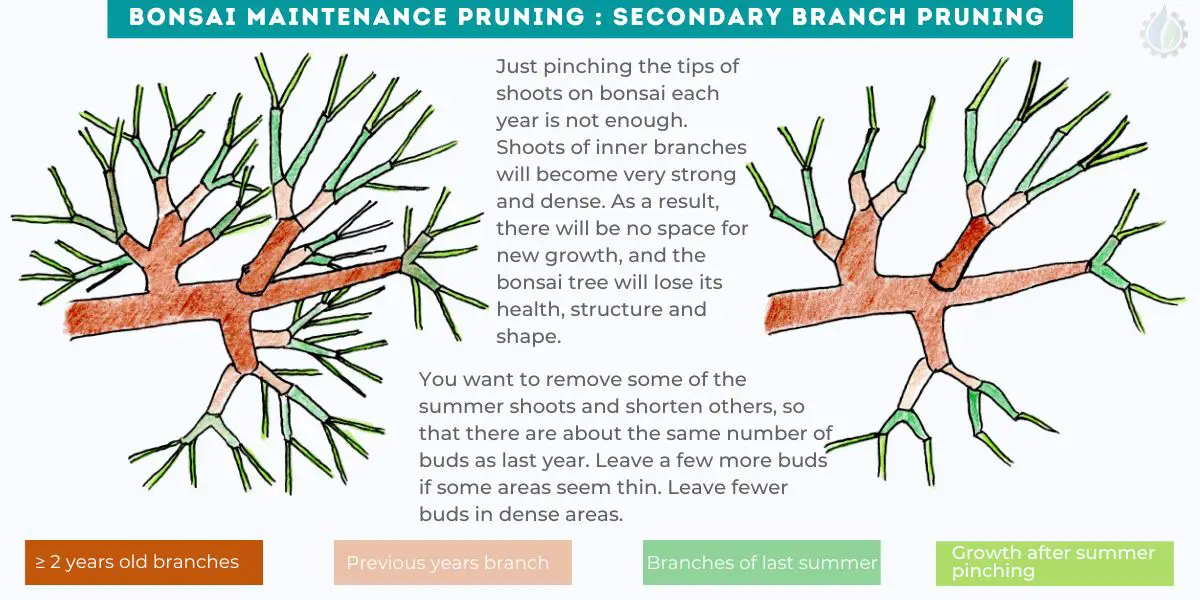
In the long run, the tree will become too large if you simply clip off the tips of the new shoots each year. Shoots of inner branches will become very strong and dense. As a result, there will be no space for new growth, and the bonsai tree will lose its health, structure and shape.
Reduce the number of buds to make room for next year’s growth and also to control the size of the bonsai tree. Every 2-4 years (depending on the type of bonsai tree), heavy pruning will be required.
This is also the stage at which you slightly change the growth plan and re-finalize the secondary and tertiary branch ramifications.
Basically, the goal is to remove or shorten some of the summer shoots, so that you are left with about the same number of buds as last year. Leave a few more buds if some areas seem thin. Leave fewer buds in dense areas.
Although this may seem excessive, it is necessary. Getting the twigs dense again will take just a year or so.
Bonsai root pruning

As part of the bonsai repotting process, roots are pruned. The tools you may require at the time of root pruning are shears, root cutter, chopsticks, root hook etc. Please read repotting bonsai tree for more details.
By pruning the roots, you can reduce the volume of woody old roots in the pot and increase the number of fine roots.
The amount of root mass to be removed depends on the type of bonsai tree. As a general rule, 1/3 of the root mass is removed. However I will still advise you to check the individual bonsai tree requirements. Refer to bonsai tree type for more details.
Do not damage or hard prune the root mass closest to the trunk of the tree. This will ensure good health of your bonsai tree. However, you can remove the central stub of the trunk in case your tree was grown from a cutting.
To promote new fibrous roots, ensure your cuts are clean and sharp when you prune old thick roots.
The roots of old trees are less abundant than those of young trees, so you’ll have fewer roots to prune.
Bonsai leaf pruning
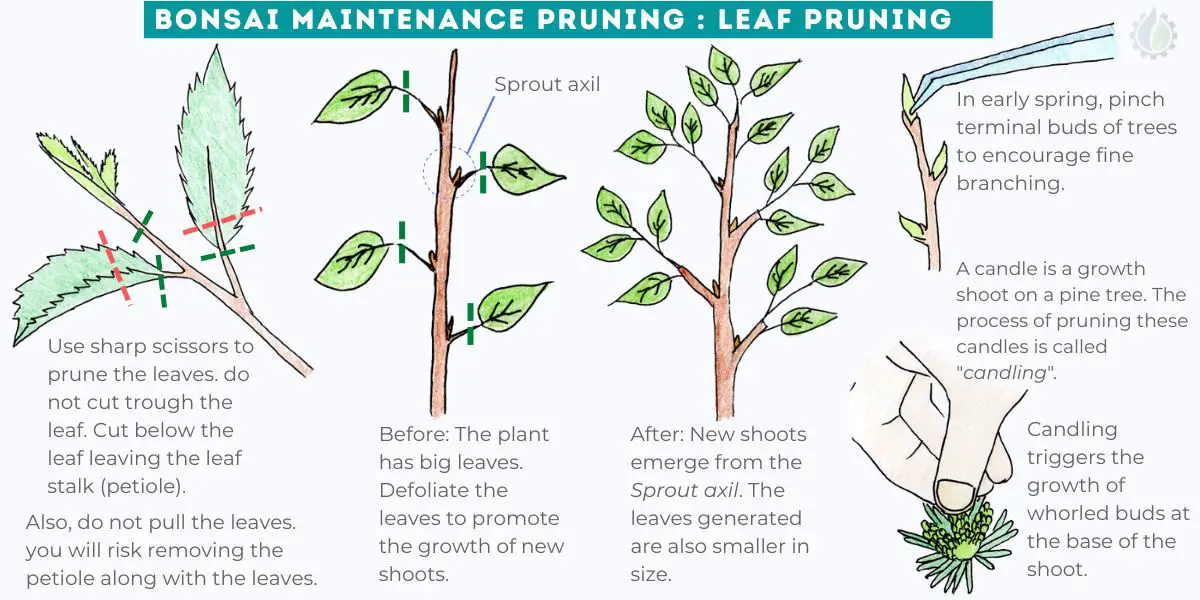
It is extremely important to trim the leaves of your bonsai tree in order to keep it well balanced.
In order to achieve a balance and natural proportion between the size of the trunk, the branches, and the crown of a tree, the primary goal is to create more and smaller leaves. (example wide leaves of deciduous trees like maple and elm)
Spring or early summer is a good time to perform leaf pruning.
After a bonsai has been stripped of its leaves, it may not look very attractive. However, eventually you will reap the rewards, since the trunk, branches, and twigs will have much more aesthetic proportions.
For smaller trees, the process of leaf pruning can prove to be very stressful for the tree. Hence it is recommended to do it in two stages.
1st stage: Prune only large leaves. 2nd stage: After 14 days prune the rest of the intended leaves.
You can, however, remove all the intended leaves at once if your plant is strong and healthy.
Whenever you trim the leaves, make sure to leave a small piece of stem, as this is where a new shoot will develop. That point is called the “sprout axil“. Do not worry about the leaf stalk you left. It will eventually fall off.
You should not pull leaves from the tree because you will likely be removing the leaf stalk and the dormant bud as well.
Only Zelkova bonsai trees have no leaf stalk and leaves can be pulled off by hand carefully.
After removing the leaves, reduce the watering frequency. The tree will need less water.
For at least the first few weeks after leaf pruning, the tree should be placed in full sun. In this way, strong buds will be encouraged.
The fall leaf color is also intensified by leaf pruning.
Buds pruning a bonsai: Buds are found not only at leaf nodes, but also on trunks and branches. It is important not to leave these buds unattended. As a result, unwanted branches will be produced, resulting in more unnecessary pruning. Pinching the terminal buds of bonsai trees such as (zelkova, elm and maple) will encourage a fine network of branches. This is best done in the season of early spring. Take the excess buds off with tweezers by plucking them off.
Candling: Pines grow candles as growth shoots. The process of breaking these candles with your fingers is called candling. Candling encourages the whorled buds at the base of the shoot to grow. Be careful when cutting candles with scissors. Cutting candles with scissors may cause them to turn brown. It is possible to remove partial candles or the whole candle, depending on the growth you’d like to stimulate.
In order to break a candle, hold the branch in one hand. With your other hand, pinch the candle with your forefinger and thumb and pull it towards you. This should cause it to break off at its base.
Similar technique can be applied to the scale like foliage of Juniper bonsai tree. Read pruning juniper bonsai tree for more details.
Can I cut all the leaves off my Bonsai?
Yes. You can completely defoliate your bonsai tree provided it is strong and healthy and has not been defoliated for several years consecutively.
You can completely defoliate a bonsai tree in the months between March and August (between spring and summer).
Perform complete defoliation in phases over a two-week period. This way you can simulate the late season dormant period (winter). But when the plant is exposed to heat, it will encourage growth of new shoots.
Complete defoliation of the tree results in more delicate branch growth and smaller leaf growth.
When defoliating, you can leave some foliage on the weaker branches.
Normally, all leaves should be removed, although foliage can be left on weaker branches that require extra strength. Due to the bare tree, the remaining leaves draw the tree’s energy into the branch, resulting in weak areas responding rapidly.
Only prune the leaves once a year as defoliation induces a lot of stress on the tree. The tree will need a considerably long time to fully recover. Also, you should keep your bonsai vigorous and well watered before you attempt to defoliate it.
Bonsai should never be defoliated and repotted in the same year, and non-vigorous trees should never be defoliated.
In case you are not completely defoliating a deciduous bonsai tree, you can remove 2/3 of the total foliage.
Can you trim a bonsai tree with scissors?
Yes. you can use scissors to trim a bonsai tree. It is essential to have a set of scissors or clippers that are both efficient and well designed in order to produce bonsai trees of the highest aesthetic quality.
There are many types of bonsai scissors. For instance, for clipping buds, there are bonsai scissors that have short blades and long, straight handles. For cutting leaves, there are bonsai scissors that have strong, thick blades and large, broad handles. Thick root pruning can also be done with these types of scissors.
List of bonsai shears that are used for pruning bonsai are : Root shears, large pruning shears, fine point shears, leaf shears, long nosed shears, wire shears.
What is special about bonsai scissors?
Bonsai scissors are specially made for bonsai work.
Although some of the bonsai pruning routines can be performed by regular over the counter shears we find in the market, but investing in a good pair of bonsai scissors is always a good idea.
Having clean cuts is the topmost priority of bonsai pruning (to avoid unsightly scars and pest and diseases of bonsai). Many types of bonsai scissors are specially made to perform specific task such as candling, root pruning, bud pruning, shoot pruning etc. On the other hand, the regular scissors we may find on our kitchen counter or stationary drawer may not be sharp and strong enough to cut through wood on a regular basis.
How do you control the height of a bonsai tree?
You can control the height of bonsai tree by regular top pruning, root pruning, and repotting the bonsai in a smaller pot.
Top pruning will stimulate growth in the lower sections of the tree along with stopping your bonsai from growing taller.
Root pruning is also a very good technique to keep the growth of bonsai in check. The lesser the roots, the lesser the nutrients absorbed by the tree. This article and bonsai repotting has all the details you need to know about root pruning.
Potting/repotting the bonsai tree on a smaller pot will also restrict the growth of the bonsai. Small bonsai pot will lead to lesser roots and lesser bonsai potting media. Please read how to choose a bonsai pot to get the right pot for your bonsai.

